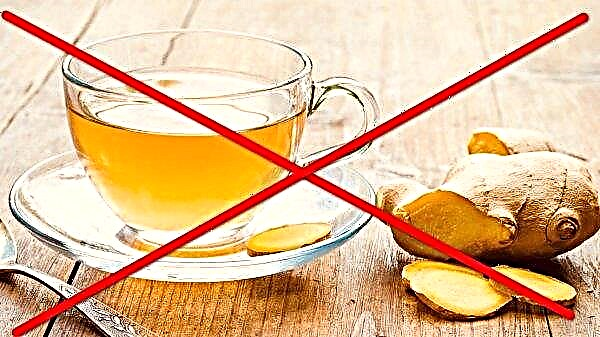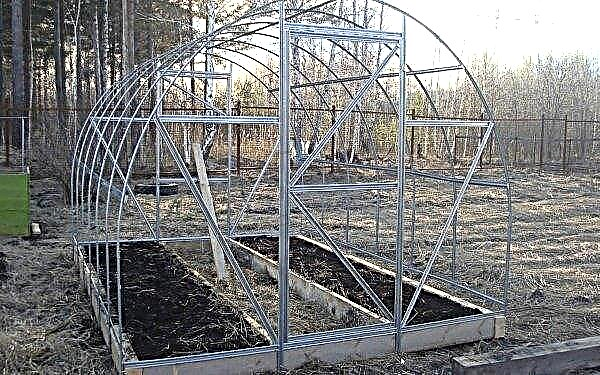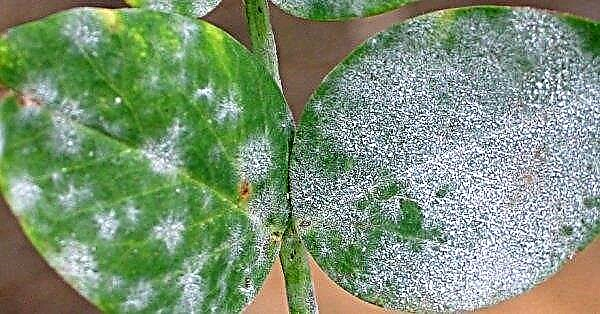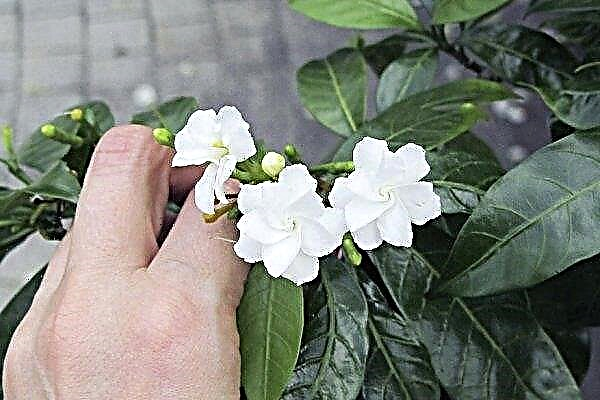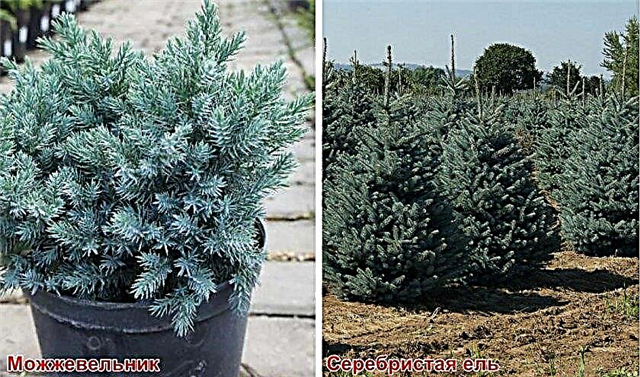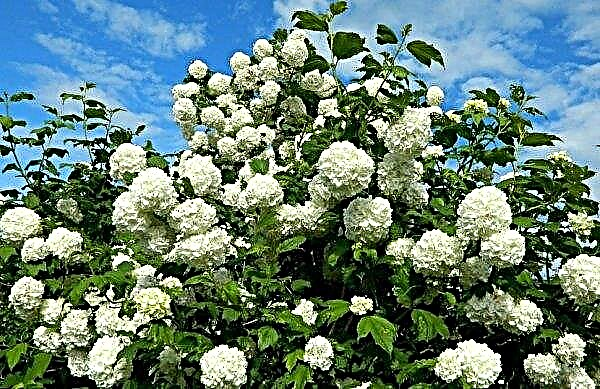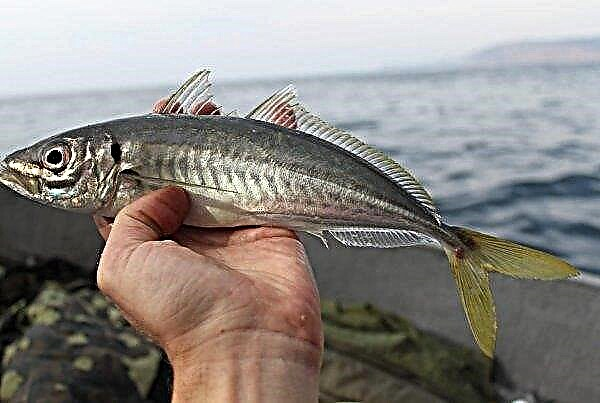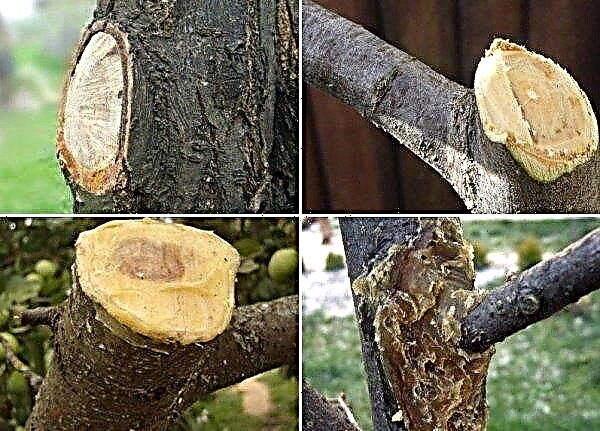Leeks were grown in ancient Egypt, and since then this vegetable has not lost its popularity. Below is a description of the plant, a description of the best varieties and the basics of crop farming.
Description and characteristics of leeks
The leek belongs to the Amaryllis family and Western Asia is considered its homeland. The plant is sometimes called "pearl onions" and it has the following botanical signs:
- 6–15 flat leaves 3–6 cm wide, up to 90 cm long;
- the color of the leaves is green, of varying degrees of saturation, with a wax coating;
- false onion-stem of white color up to 50 cm long, up to 8 cm thick;
- a white bulb with 1-2 membranous scales, with a small number of bulbs or without them;
- the size of the bulb is 2–6 cm in length and 2–7 cm in diameter;
- flower arrow 100-150 cm high (up to 200 cm in the south);
- inflorescence in the form of a spherical umbrella with a diameter of up to 25 cm of white or lilac color;
- 3–8 small, “pearl” bulbs are formed on the bottom;
- seeds are small (approximately 2.5-3 g weighs 1000 pcs.).

Leek is a biennial plant. In the first vegetative season, a false bulb-stem and leaves are formed, and the next year a flower arrow and inflorescence are formed. Air bulbs appearing in an umbrella can be used for reproduction.
The culture belongs to the winter-hardy type and, with sufficient snow cover, can wait for spring in the open ground. A white stem base is used for food, which has a more delicate and less sharp taste than other types of onions. Also considered a medicinal plant.
Did you know? The content of leek ascorbic acid grows 1.5 times during storage of the vegetable. Beneficial substances pass into the white part of the left leaves.
Varieties of leeks
Varieties of vegetables are divided into 3 groups depending on the length of the growing season. Each of them is suitable for cultivation in all regions and is included in the State Register of plants approved for use.
Early grades
This group is characterized by increased productivity and will be ready for harvesting after 130-150 days, however, it is not recommended for long-term storage.
- Vesta. Russian variety of the 90s of XX. Total height up to 140 cm, length of the bleached stem 26–50 cm, diameter 2-3 cm, weight 210–230 g. Average productivity 5.7 kg / m².
- Columbus Dutch onions from Bejo Zaden were registered in the register in 2005. The bleached part grows up to 18 cm in length with a diameter of 3–6 cm and weighs 300–400 g. It has excellent taste and practically does not require hilling. Productivity is 3.1 kg / m².
- Jumper. This onion was also bred in Bejo Zaden and entered into the register in 2013. The hybrid forms a white leg 20–25 cm long with a diameter of 4 cm and a weight of 250–350 g. The crop yield is 2.5 kg / m².

Mid-season leek
These varieties ripen within 150–180 days and, although they do not show such a high yield, they are characterized by better product quality. Frost resistance of this group is up to -7 ° C. Harvest safety is good.
- Casimir. German onions from SAATZUCHT QUEDLINBURG GMBH were entered into the register in 1998. The length of the white false stem is 22–26 cm and the diameter is 3–3.5 cm. Yield 2.9 kg / m². The bulb is slightly expressed, which facilitates peeling and cleaning.
- Camus. The product of the Czech agricultural company MORAVOSEED was entered in the register in 1995. The length of the white part is 18–20 cm, the diameter is 1.8–2.2 cm. It has a slightly sharp taste. Productivity 2.5–3.2 kg / m².
- Tango. Another Czech variety was added to the register in 1997. Onions have an average height, a “leg” length of up to 15 cm and a diameter of up to 5 cm, the weight of the productive part is 200–250 g. It has high frost resistance for the mid-season group. Accurate yield data are not available, the register indicates “high productivity”.
Varieties of late ripening
Varieties of this group have a vegetation period of more than 180 days and yield similar to the previous group. Ideal for long-term storage.On average, they have a sharper taste than early and mid-ripening varieties.
- Asgeos. This onion was bred in the Moscow Region and registered in 1995. The white part is dense, 16-17 cm long and 3.5–3.8 cm in diameter. Product weight 320–350 g. Yield 2.28–3.43 kg / m² . Mechanized cultivation is possible.
- Elephant MS . The Czech variety was approved for cultivation in 1995. The bleached portion is 10–25 cm long, medium diameter. The taste is spicy. The mass of the vegetable is 200 g. Yield 3.2–3.8 kg / m². It is characterized by high frost resistance and low watering requirements.
- Quarantine. One of the oldest Russian varieties included in the register as far back as 1961. The white stem reaches a length of 10–25 cm and its diameter is about 4 cm. Weight 200–325 g. Onion has a semi-sharp taste and yields 2.1–2. 58 kg / m². A high percentage of marketability is 98-100%.

Features of planting and growing leeks at home
Leek is usually grown through seedlings in one year. For this crop, it is most important to determine the optimal sowing time and provide the seedlings with the required conditions. In the southern regions, seeds can be sown immediately in open ground, since climatic conditions allow the plant to fully form the ground part.
Optimal timing
When choosing a date for sowing seeds, the length of the growing season of the selected variety should be considered. The interval before planting in open ground should be approximately 60 days. On average, sowing is performed in early to mid-March. If seedlings are grown in an insulated greenhouse, this period is shifted to mid-April, and leeks can be sown in film-covered beds at the end of April. With the seedling method of cultivation, sowing in the ground is carried out around mid-May, when the heat has finally settled.
Did you know? The Emperor of Ancient Rome Nero earned the nickname "Leek-eating." He ate a vegetable in large quantities, believing that leek retains a voice for long speeches.
Site selection and soil preparation
It is best to plant onions in an open sunny area. The bed for leek should contain loose and nutritious soil with a neutral reaction. The culture can be grown after legumes, pumpkins or potatoes.
To prepare the land in advance, the following actions should be performed in the fall:
- clear the bed of weeds and dig;
- to introduce complex fertilizer (nitrophoska) at the rate of 2 tbsp. tablespoons per 1 m².
Preparing planting material
Leek seeds can be sold already in a processed state, which should be indicated on the package. Visually, this is determined by the color of the seeds: ordinary seeds are black, processed can be green, blue, etc.
Conventional seeds should be preliminarily prepared in one of the following ways:
- soak in non-cold water for a day and then dry;
- or soak in a thermos at a water temperature of + 40 ° C for 2–4 hours, then rinse with cool water and dry;
- dip in water for several seconds at + 45 ° C, then immediately transfer to cold water. Transfer the seeds to a damp cloth and germinate at a temperature of + 25 ° C for several days.

Additionally, you can perform dressing with 1% potassium permanganate solution for 30 minutes, followed by washing the seeds in clean water.
Important! Leek seeds sharply reduce germination 3 years after harvest.
Sowing seeds
Leek is best grown without picking (planting in separate pots), therefore, it is most convenient to sow seedlings immediately in separate cassettes or peat tablets. Standard boxes are also suitable.
When sowing in a greenhouse or box, the seeds are distributed at a depth of 1 cm in rows with an interval of at least 5 cm. Between future shoots there should be at least 2 cm. Sowing is covered with a film or glass and left at a temperature of about + 22 ° C.
Seedling & Hardening
In the first week after germination, you should lower the temperature to + 15 ... + 17 ° C during the day and + 10 ... + 12 ° C at night. In the second week, the amount of heat is slightly increased (up to + 21 ° C during the day and + 14 ° C at night) and is left in this mode. Sprouts are poured with warm water as the soil dries. Please note that seedlings need 10-12 hours of light day. If there is not enough light, they organize additional illumination.For top dressing, every 2 weeks you can sprinkle the sprouts with compost tea or special fertilizer for seedlings.
To enhance root growth and thicken the stem, it is recommended to cut the seedlings several times to a leaf length of 10 cm. Approximately 8 weeks after germination, the diameter of the stem will reach about 8 mm, and the length of these leaves will be about 15 cm, seedlings begin to be prepared for planting on the garden bed. Seedlings are taken out to the shaded place, gradually increasing the time spent in the air from half an hour to a whole day.
Open transplant
For transplantation, you should choose a cloudy day or evening time, when the bright rays of the sun can not burn the young leaves. Before work, the plants are well moisturized.
There are two options for planting leeks:
- multirow, at which the row spacing is 20-30 cm, and the plants are located at a distance of 10-15 cm;
- double row, with an interval between the holes of 15–20 cm, and between the rows leave 30–35 cm.
- Prepare a hole with a depth of 15 cm. Pour a handful of ash onto the bottom, mix and spill.
- Get the plant and cut the root system and leaves by a third. If the seedlings are weak, pruning is not carried out. The roots can be dipped in a talker of manure and clay.
- Plant the onion to a depth of at least 10 cm.
- Around each plant, make a small indentation in the form of a ring, to protect the sprouts from the wind and simplify watering. Moisturize slightly.

Onion Care
Culture is sensitive to proper care. To get tasty bleached parts, special attention should be paid to watering, top dressing, hilling and cultivating. Sometimes it requires plentiful watering during the growing season. The soil near the plants should be moistened 7-10 cm deep. On average, you need to water the garden 3 times a week.
Every 1-2 weeks, the soil is loosened to give oxygen and water access to the root system of the plant. When the diameter of the stem reaches 5–7 mm, they begin to pick up soil from the walls of the landing trench. Hilling is repeated every 2 weeks.In order not to clog the leaves with earth, you can replace the earthing up with high mulching with dry grass.
Some gardeners wrap stems with thick paper. Fertilizing is performed simultaneously with watering with a frequency of 1 time in 2-3 weeks. The first time the procedure is carried out 3 weeks after planting. The best fertilizer is infusion of chicken droppings (1:20) or manure (1: 8).
How to propagate leeks?
To obtain seeds, the plant must enter the second year of vegetation and release a flower arrow. After flowering, seed bolls are formed in the umbrella (3-4 pcs. In 1 box). The “pearl” bulbs formed during flowering can also be planted, thus using vegetative propagation of the crop. The above methods can be used only in the southern regions, since in the north leek is unlikely to winter, and its seeds will not have time to ripen.
Possible growing problems
Most often, plants are attacked by an onion fly. Her larvae climb inside the stem and feed on its juice.
For the prevention and control of the pest, the following methods are used:
- maximum diversity of onion plantings;
- early sowing;
- combined planting with carrots, the smell of which repels flies;
- at the beginning of the growing season, plants can be treated with insecticides.
- powdery mildewin which a white coating is noticeable on the leaves of the onion. Diseased foliage dies early, which is the reason for a significant decrease in yield. For prevention, the mandatory actions will be the destruction of plant debris and crop rotation. Growth regulators can provide some help, and at the beginning of the disease, spraying with “Topsin M” or “Quadrice” will become effective;

- alternariosis It spreads in warmth and high humidity. Most often, plants that are already weakened by powdery mildew or fusariosis and those that have received an excess of nitrogen fertilizing become infected with the disease. Infected leaves become covered with black fungal plaque, then they die themselves and cause the death of the whole plant. In case of illness, fungicides are used that are identical to those recommended for onions ("Acrobat", "Horde", "Quadris", etc.).

Harvesting and storage
Harvest time depends on the variety planted. During harvesting, each plant is carefully dug up, avoiding the ingress of soil between the leaves. The roots are partially shortened, while the bottom of the bulb should remain intact. Left leaves will protect leeks from drying out quickly. Several plants can be left in the ground for the whole winter, insulated with spruce branches or dry peat. In spring, you can use them both for food and for seeds.
The resulting crop can be saved in several ways.:
- place the onion vertically in a box with a sand layer of 5 cm. Between the plants add 15 cm of wet sand. At a temperature of about 0 ° C, this method will ensure the safety of the product for up to 6 months;
- the strongest specimens can be stored in the refrigerator for up to 5 months. To do this, peel the onion, cool it in the open form to -2 ... + 2 ° C, then quickly pack it in bags with perforation (up to 8 pcs. In 1 bag);
- sheltered leek is perfectly stored on the balcony.

Leeks can also be frozen or dried:
- for freezing, the white stem is cut into rings or cubes, packaged and placed at a temperature of -18 ° C;
- drying is carried out at a temperature of + 50 ° C and above using a special electric dryer or oven.
Important! The roots of the leek left in the ground after harvest, well enrich its composition with organic matter.
Leek can be grown in any household plot, picking a variety with an optimal ripening period. Compliance with the basic principles of care will allow you to get a good harvest of healthy and tasty vegetables.



